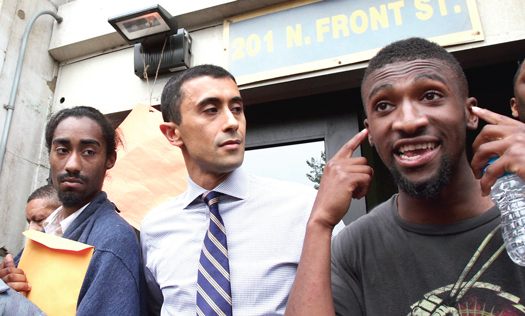Blacks, Latino educators struggle in profession
By Stacy M. Brown -Special to the NNPA | from the Afro-American Newspaper- | Last updated: Aug 6, 2014 - 5:41:57 PMWhat's your opinion on this article?

DeJohn Sullivan, right, a senior at Camden High School, tells the protesting students to listen to what Superintendent Paymon Rouhanifard, center, has to say as fellow student Samir Nichols looks on May 14, in Camden, N.J. Over 300 students walked out of their schools and marched to the Camden City Board of Education Administration Building to protest teacher layoffs. Photo: A/P World Wide Photos
|
Minorities are significantly underrepresented in public schools, despite the fact that the number of Black and Latino students have increased.
A new report from the Center for American Progress (CAP) in Northwest — “The Leaky Pipeline for Teachers of Color: Getting More Teachers of Color into the Classroom” — revealed while much has been done in the past 25 years to substantially increase the number of minority teachers, high levels of attrition has offset that success.
“If you spend time in almost any major school district in America today, you will notice that the students often do not look much like the teachers. In fact, in some areas, the students don’t look anything like their teachers,” said Ulrich Boser, a senior fellow at CAP. “There is a significant demographic gap in the largely White teaching profession and an increasingly diverse student population,” he said.
Released July 7, the report revealed Blacks and Latinos are more likely to work and remain in high-poverty, hard-to-staff urban schools and districts than their White counterparts; in fact, they often consider it their duty to do so.
What’s more, minority teachers usually are committed to the success of children of color, and they affect a wide range of student academic outcomes, the report’s authors said. They also serve as powerful role models for all students and prove that teaching can be a viable career for minorities.
Deaundra Francis, of Northeast who holds a Master’s of Public Administration, said there are three major hurdles facing minorities who aspire to become teachers.
“After working at the University of Louisiana at Lafayette in the Teacher Prep Student Support Services program, we found that Black, low-income, first-generation college students had barriers that prevented them from completing their education degrees,” Ms. Francis said.
“Because it’s required by most states and higher education institutions to pass the Praxis I and II exams as well as all required courses, minorities have not been able to do so and they change their majors to something more compatible,” she said. “The second barrier is the financial and family obligations which may hinder future progress toward an education degree and the third barrier that I propose has to do with culture.”
Melissa Mesku, also of Northeast, who works for New Worker magazine, said she once taught at a high school in a poverty-stricken New York neighborhood and circumstances made it difficult for her to continue her career.
“I’m a woman of color and I taught English as a second language [ESL] for refugee and immigrant students and most of the newer teachers were also minorities at my school,” Ms. Mesku said. “I stayed for a year. Coming from a disadvantaged economic background, I simply couldn’t afford to continue to live on a teacher’s salary. If I wanted upward mobility, I had to move on to more lucrative work, especially considering the difficulties and commitments required to work in a hard-to-staff school and spending my own money to clothe and feed students and working 13 hours per day with no resources or books.”
INSIDE STORIES AND REVIEWS
-
-
About Harriett ... and the Negro Hollywood Road Show
By Rabiah Muhammad, Guest Columnist » Full Story -
Skepticism greets Jay-Z, NFL talk of inspiring change
By Bryan 18X Crawford and Richard B. Muhammad The Final Call Newspaper @TheFinalCall » Full Story -
The painful problem of Black girls and suicide
By Charlene Muhammad -National Correspondent- » Full Story -
Exploitation of Innocence - Report: Perceptions, policies hurting Black girls
By Charlene Muhammad -National Correspondent- » Full Story -
Big Ballin: Big ideas fuel a father’s Big Baller Brand and brash business sense
By Bryan Crawford -Contributing Writer- » Full Story






 Click Here Stay Connected!
Click Here Stay Connected!








